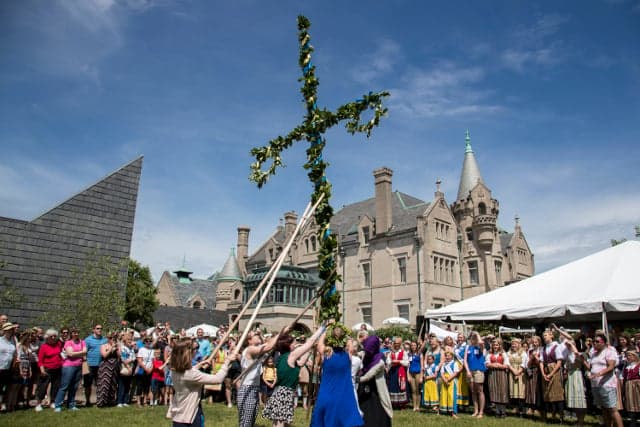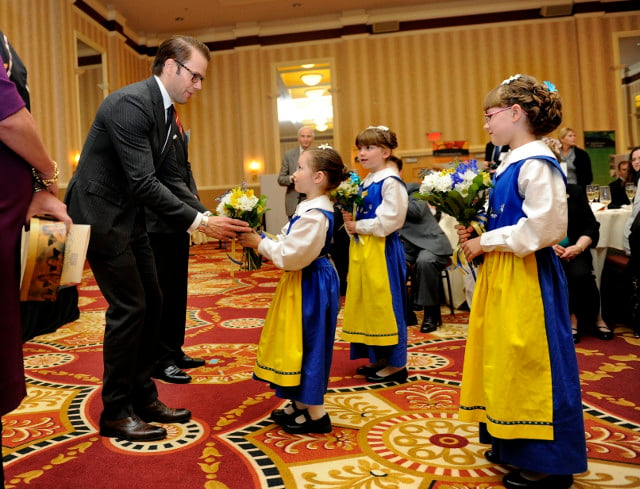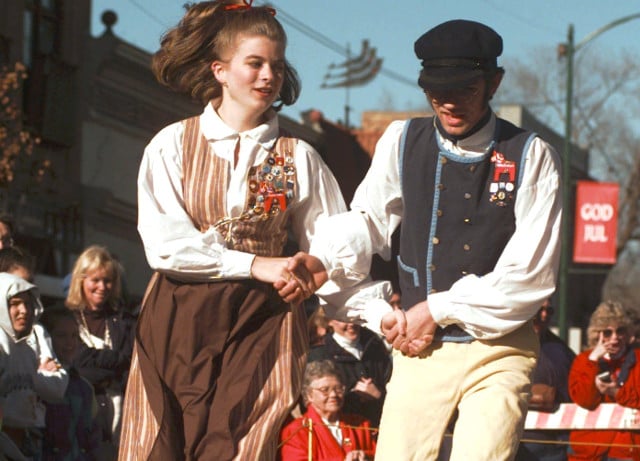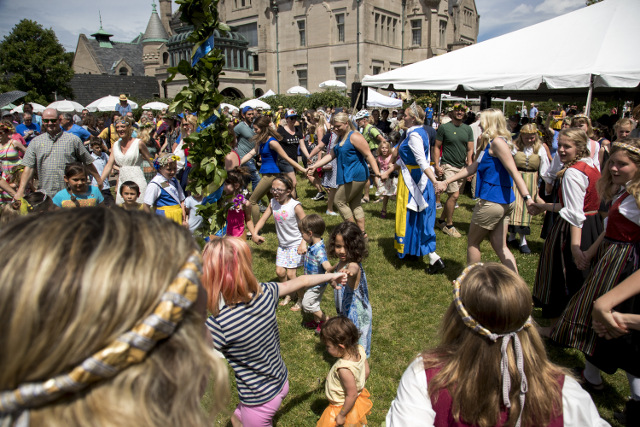Why Swedish-American culture can help build bridges for new immigrants

What does it mean to be a Swedish-American? The answer depends on who you ask. American historical writer Victoria Martinez, who now lives in Småland, Sweden, gets to the heart of the matter.
This article is available to Members of The Local. Read more Membership Exclusives here.
Anyone who has lived for an extended period outside their native country probably knows how difficult integrating into another culture can be. In addition to barriers like language, which may hinder full understanding of other cultural norms and traditions, most people carry with them some sort of emotional and ideological commitment to their native culture that they can't or won't replace.
Throughout history, this has resulted in a multi-cultural identity that can be passed down through the generations, or even lost and then reclaimed by later generations. This has been particularly true in the United States – the historical "melting pot" of ethnic identity and culture. While the topic of hyphenated American identity has long been controversial, for many modern Americans, a cultural identity as "X-American" is a badge they wear proudly, even when it is rooted in the past rather than the present.
One of these is the Swedish-American identity, which originated mainly in the mass emigration from Sweden that saw the bulk of some 1.3 million Swedes settle in the United States between 1830 and 1930. For many, this identity carries with it a commitment to Swedish-American culture that is amplified and nuanced by more modern phenomena like genealogical tourism (also called ancestral travel), recent migration between the two countries, and even television series like "Allt för Sverige".
But what is Swedish-American culture exactly and what relevance does it have today?
Speaking the Same Language Differently
The term "Swedish-American culture" is one that defies a single, all-encompassing definition. Personal interpretations and points-of-view mean it can have quite varied definitions.
For Judi Blomberg of Minnesota, who is descended from a host of Swedish immigrants to the U.S., the definition emanates from the past.
"Swedish American Culture has its roots in the culture and traditions brought to America by the Swedish immigrants. Those traditions over the years have been adapted to reflect the contemporary American lifestyle and modern Sweden while still embracing our Swedish heritage of the past," Judi told The Local.
Though his definition of Swedish-American culture isn't radically different, Allan Mutén, a native-born Swede living in the U.S. who identifies strongly as "Swedish-American", naturally focuses less on the historical fusion of cultures.
"It means being an informed and respectful observer, and to the degree one can do so, also a positive contributor to current events in both countries, being aware and reasonably observant and respectful of traditions, and ideally knowing when to step back and not be a silly ass," he wrote.
In fact, Swedish-American culture has always been interpreted in different ways, just as it's always been malleable. It didn’t mean the same thing to the Swedish immigrants of the 19th century that it meant to those who settled the New Sweden colony in America’s Delaware Bay in the 17th century, just as it didn't mean the same to Swedish immigrants who settled in the U.S. from different regions in Sweden. Fundamentally, however, the red thread that connects all periods, interpretations and definitions of Swedish-American culture is simply the desire to maintain a cultural connection with Sweden.

Sweden's Prince Daniel visiting Old New Sweden in Delaware. Photo: Jessica Gow/TT
The U.S. has historically offered an ideal environment for this to happen, argues Professor Dag Blanck, Director of the Swedish Institute for North American Studies (SINAS) at Uppsala University.
"American nationality is defined more by political-ideological identity than cultural identity. You become American by 'signing up' to certain ideals, such as those in the Declaration of Independence and the U.S. Constitution," he explained. "So the cultural identity brought from somewhere else can be maintained at the same time as long as the two don't come into conflict."
Historically, the relative ease of maintaining a Swedish cultural identity in the United States didn't mean that there wasn’t division amongst Swedish-Americans over what Swedish-American culture should be. For instance, the late Swedish-American historian H. Arnold Barton wrote in his book, "Letters from the Promised Land: Swedes in America, 1840-1914", published in 2000:
"There was fierce rivalry between [Swedish-language] church papers like the old Hemlandet or the Methodist Sdndebudet and the new secular newspapers. The latter were put out by a colorful group of bohemian intellectuals… who characteristically had left Sweden in revolt against worn-out conventions and social constraints, and who therefore were strongly influential in forming a sense of specifically Swedish-American – as opposed to Swedish – identity among their countrymen in America."
This theme appears to some extent even today since the Swedish culture preserved and perpetuated in the United States is based on regionally-diverse traditions that the Swedish immigrants brought with them a century or more ago. Scholars like Professor Blanck and H. Arnold Barton have pointed out that certain aspects of Swedish culture were preserved and adapted to American life while others were discarded.
This can manifest itself when Swedes visiting or living in the United States encounter "traditional" Swedish cultural activities such as Midsummer and Lucia Day festivities organized by Swedish-American groups. In many cases, these events and the various Swedish-American organizations Swedes seek out can seem antiquated, said Professor Blanck, who divides his time between Sweden and the Swenson Swedish Immigration Research Center in Illinois.
"There is misunderstanding on both sides," he has stated in the past. "Swedish Americans who go to Sweden cannot find the Sweden that they have grown up hearing about. Similarly, Swedish nationals do not recognise themselves in the American Swedishness, and sometimes laugh at it, finding it sentimental. But it is important to understand that the American Swedishness is not 'inferior', just different. It has evolved according to its own logic and should be understood in that light. It is like a dialect."
Bridging Cultures Across Time and Place
It could be argued that this idea of Swedish-American culture – or any other form of multiculturalism – as a dialect has social and political relevance today. After all, if dialects of language can develop and thrive within most modern societies, shouldn’t the same be true for the "dialects of culture" that spring from multiculturalism? Or is total assimilation the only way to integrate and be fully accepted in a society?
Judging by the continued existence of Swedish-American and other multiethnic cultures throughout U.S. history, it might seem easy to say that it is indeed possible to achieve full acceptance through cultural integration (at least in the U.S.). But the reality is that harmony has existed only in relative terms throughout much of this history, even among the generally advantaged Swedish immigrants who entered the U.S. with an ethnic privilege. But they were still immigrants, and immigrants always face barriers to full social acceptance and integration—some more than others.

Swedish-American folk dancers in Lindsborg, Kansas. Photo: Jessica Gow/TT
Historically, many of the first-generation Swedish immigrants to the U.S. banded together in completely-or predominantly-homogenous immigrant communities, such as New Sweden, Iowa, and Bishop Hill, Illinois. There were even Swedish slums like Swede Hollow in St. Paul, Minnesota, the subject of a 2016 eponymous Swedish novel by Ola Larsmo.
By the 1890s, Swedish-Americans were "under increasing pressure to examine, explain, and justify their own community, in the face both of harder conditions in the United States, including a rise in anti-immigration sentiment, and of an increasingly militant opposition to emigration and criticism of the Swedish Americans in Sweden," wrote H. Arnold Barton in his 1994 book "A Folk Divided: Homeland Swedes and Swedish Americans, 1840-1940".
For the intellectual elite of the Swedish-American community, Professor Blanck has written, the "creation of a Swedish-American cultural tradition in the new land" became not only an integration tool for Swedish-Americans, but also a way of being fully accepted as Americans.
In a 1996 article in the Scandinavian Review, entitled "On Being Swedish in America: The Search for Identity", Blanck wrote, "This was an ethnic identity that drew on the cultural repertoire that Swedish-Americans brought with them from Sweden, but in a very selective way. It was precisely these aspects of their cultural heritage that gave the Swedish-Americans the capacity to fit into the larger American context."
Around the world today, immigrants face a similar struggle to integrate and gain social acceptance into an adopted culture while still retaining some degree of their own cultural identity. Between assimilation and integration, there lies an ambiguous area for which there exists no practical road map. Even if there were a road map, it’s unlikely any route would provide a direct or smooth path to unconditional acceptance.
Not surprisingly, there appears to be an awareness of this among those who identify as multicultural. This was expressed in the answers to The Local’s questionnaire about Swedish-American culture. These answers also demonstrated that identification as Swedish-American takes a variety of forms in our increasingly globalized world.

The American Swedish Institute celebrating Midsummer in Minneapolis. Photo: Courtney Pedroza/ST Paul Pioneer Press/AP
Melissa Johnson, for instance, is an American of Swedish descent living in Sweden who identifies strongly as Swedish-American. She amusingly described how her Americanized Swedish last name – which was originally Johansson, but is also similar in its current spelling to Jonsson – creates no small amount of confusion in Sweden and requires regular explanation. For her, sharing her story and experiences "to try to help others with their own moves and adapting into Swedish culture" is incredibly important and prompted her to start a blog about "Becoming Swedish".
On the other side of the Atlantic, Judi Blomberg of Minnesota has also found a way to use her heritage and her ancestors’ experiences to help new immigrants to the U.S. As a regular volunteer at the American Swedish Institute in Minneapolis, she provides tours of the historic Turnblad Mansion – once the home of Swan Turnblad, a Swedish immigrant to the U.S. who became owner and publisher of the country’s largest Swedish-language newspaper – and shares stories about Swedish immigration to America. She has also been a part of a program called Story Swap, which, she wrote, "is intended to build bridges to new immigrants and foster understanding of the challenges faced by those immigrants."
Even if we can't answer philosophical questions about the "dialects of culture" as a path to integration within societies, we can perceive that the modern relevance of Swedish-American culture, and other forms of multiculturalism, may very well be found in efforts that build bridges through the experiences of immigrants across cultures, eras, and geography.
Victoria Martínez is an American historical researcher, writer and author of three historical non-fiction books. She lives in Småland county, Sweden, with her Spanish husband and their two children.
Read more from her family and history column on The Local here.
Comments
See Also
This article is available to Members of The Local. Read more Membership Exclusives here.
Anyone who has lived for an extended period outside their native country probably knows how difficult integrating into another culture can be. In addition to barriers like language, which may hinder full understanding of other cultural norms and traditions, most people carry with them some sort of emotional and ideological commitment to their native culture that they can't or won't replace.
Throughout history, this has resulted in a multi-cultural identity that can be passed down through the generations, or even lost and then reclaimed by later generations. This has been particularly true in the United States – the historical "melting pot" of ethnic identity and culture. While the topic of hyphenated American identity has long been controversial, for many modern Americans, a cultural identity as "X-American" is a badge they wear proudly, even when it is rooted in the past rather than the present.
One of these is the Swedish-American identity, which originated mainly in the mass emigration from Sweden that saw the bulk of some 1.3 million Swedes settle in the United States between 1830 and 1930. For many, this identity carries with it a commitment to Swedish-American culture that is amplified and nuanced by more modern phenomena like genealogical tourism (also called ancestral travel), recent migration between the two countries, and even television series like "Allt för Sverige".
But what is Swedish-American culture exactly and what relevance does it have today?
Speaking the Same Language Differently
The term "Swedish-American culture" is one that defies a single, all-encompassing definition. Personal interpretations and points-of-view mean it can have quite varied definitions.
For Judi Blomberg of Minnesota, who is descended from a host of Swedish immigrants to the U.S., the definition emanates from the past.
"Swedish American Culture has its roots in the culture and traditions brought to America by the Swedish immigrants. Those traditions over the years have been adapted to reflect the contemporary American lifestyle and modern Sweden while still embracing our Swedish heritage of the past," Judi told The Local.
Though his definition of Swedish-American culture isn't radically different, Allan Mutén, a native-born Swede living in the U.S. who identifies strongly as "Swedish-American", naturally focuses less on the historical fusion of cultures.
"It means being an informed and respectful observer, and to the degree one can do so, also a positive contributor to current events in both countries, being aware and reasonably observant and respectful of traditions, and ideally knowing when to step back and not be a silly ass," he wrote.
In fact, Swedish-American culture has always been interpreted in different ways, just as it's always been malleable. It didn’t mean the same thing to the Swedish immigrants of the 19th century that it meant to those who settled the New Sweden colony in America’s Delaware Bay in the 17th century, just as it didn't mean the same to Swedish immigrants who settled in the U.S. from different regions in Sweden. Fundamentally, however, the red thread that connects all periods, interpretations and definitions of Swedish-American culture is simply the desire to maintain a cultural connection with Sweden.

Sweden's Prince Daniel visiting Old New Sweden in Delaware. Photo: Jessica Gow/TT
The U.S. has historically offered an ideal environment for this to happen, argues Professor Dag Blanck, Director of the Swedish Institute for North American Studies (SINAS) at Uppsala University.
"American nationality is defined more by political-ideological identity than cultural identity. You become American by 'signing up' to certain ideals, such as those in the Declaration of Independence and the U.S. Constitution," he explained. "So the cultural identity brought from somewhere else can be maintained at the same time as long as the two don't come into conflict."
Historically, the relative ease of maintaining a Swedish cultural identity in the United States didn't mean that there wasn’t division amongst Swedish-Americans over what Swedish-American culture should be. For instance, the late Swedish-American historian H. Arnold Barton wrote in his book, "Letters from the Promised Land: Swedes in America, 1840-1914", published in 2000:
"There was fierce rivalry between [Swedish-language] church papers like the old Hemlandet or the Methodist Sdndebudet and the new secular newspapers. The latter were put out by a colorful group of bohemian intellectuals… who characteristically had left Sweden in revolt against worn-out conventions and social constraints, and who therefore were strongly influential in forming a sense of specifically Swedish-American – as opposed to Swedish – identity among their countrymen in America."
This theme appears to some extent even today since the Swedish culture preserved and perpetuated in the United States is based on regionally-diverse traditions that the Swedish immigrants brought with them a century or more ago. Scholars like Professor Blanck and H. Arnold Barton have pointed out that certain aspects of Swedish culture were preserved and adapted to American life while others were discarded.
This can manifest itself when Swedes visiting or living in the United States encounter "traditional" Swedish cultural activities such as Midsummer and Lucia Day festivities organized by Swedish-American groups. In many cases, these events and the various Swedish-American organizations Swedes seek out can seem antiquated, said Professor Blanck, who divides his time between Sweden and the Swenson Swedish Immigration Research Center in Illinois.
"There is misunderstanding on both sides," he has stated in the past. "Swedish Americans who go to Sweden cannot find the Sweden that they have grown up hearing about. Similarly, Swedish nationals do not recognise themselves in the American Swedishness, and sometimes laugh at it, finding it sentimental. But it is important to understand that the American Swedishness is not 'inferior', just different. It has evolved according to its own logic and should be understood in that light. It is like a dialect."
Bridging Cultures Across Time and Place
It could be argued that this idea of Swedish-American culture – or any other form of multiculturalism – as a dialect has social and political relevance today. After all, if dialects of language can develop and thrive within most modern societies, shouldn’t the same be true for the "dialects of culture" that spring from multiculturalism? Or is total assimilation the only way to integrate and be fully accepted in a society?
Judging by the continued existence of Swedish-American and other multiethnic cultures throughout U.S. history, it might seem easy to say that it is indeed possible to achieve full acceptance through cultural integration (at least in the U.S.). But the reality is that harmony has existed only in relative terms throughout much of this history, even among the generally advantaged Swedish immigrants who entered the U.S. with an ethnic privilege. But they were still immigrants, and immigrants always face barriers to full social acceptance and integration—some more than others.

Swedish-American folk dancers in Lindsborg, Kansas. Photo: Jessica Gow/TT
Historically, many of the first-generation Swedish immigrants to the U.S. banded together in completely-or predominantly-homogenous immigrant communities, such as New Sweden, Iowa, and Bishop Hill, Illinois. There were even Swedish slums like Swede Hollow in St. Paul, Minnesota, the subject of a 2016 eponymous Swedish novel by Ola Larsmo.
By the 1890s, Swedish-Americans were "under increasing pressure to examine, explain, and justify their own community, in the face both of harder conditions in the United States, including a rise in anti-immigration sentiment, and of an increasingly militant opposition to emigration and criticism of the Swedish Americans in Sweden," wrote H. Arnold Barton in his 1994 book "A Folk Divided: Homeland Swedes and Swedish Americans, 1840-1940".
For the intellectual elite of the Swedish-American community, Professor Blanck has written, the "creation of a Swedish-American cultural tradition in the new land" became not only an integration tool for Swedish-Americans, but also a way of being fully accepted as Americans.
In a 1996 article in the Scandinavian Review, entitled "On Being Swedish in America: The Search for Identity", Blanck wrote, "This was an ethnic identity that drew on the cultural repertoire that Swedish-Americans brought with them from Sweden, but in a very selective way. It was precisely these aspects of their cultural heritage that gave the Swedish-Americans the capacity to fit into the larger American context."
Around the world today, immigrants face a similar struggle to integrate and gain social acceptance into an adopted culture while still retaining some degree of their own cultural identity. Between assimilation and integration, there lies an ambiguous area for which there exists no practical road map. Even if there were a road map, it’s unlikely any route would provide a direct or smooth path to unconditional acceptance.
Not surprisingly, there appears to be an awareness of this among those who identify as multicultural. This was expressed in the answers to The Local’s questionnaire about Swedish-American culture. These answers also demonstrated that identification as Swedish-American takes a variety of forms in our increasingly globalized world.

The American Swedish Institute celebrating Midsummer in Minneapolis. Photo: Courtney Pedroza/ST Paul Pioneer Press/AP
Melissa Johnson, for instance, is an American of Swedish descent living in Sweden who identifies strongly as Swedish-American. She amusingly described how her Americanized Swedish last name – which was originally Johansson, but is also similar in its current spelling to Jonsson – creates no small amount of confusion in Sweden and requires regular explanation. For her, sharing her story and experiences "to try to help others with their own moves and adapting into Swedish culture" is incredibly important and prompted her to start a blog about "Becoming Swedish".
On the other side of the Atlantic, Judi Blomberg of Minnesota has also found a way to use her heritage and her ancestors’ experiences to help new immigrants to the U.S. As a regular volunteer at the American Swedish Institute in Minneapolis, she provides tours of the historic Turnblad Mansion – once the home of Swan Turnblad, a Swedish immigrant to the U.S. who became owner and publisher of the country’s largest Swedish-language newspaper – and shares stories about Swedish immigration to America. She has also been a part of a program called Story Swap, which, she wrote, "is intended to build bridges to new immigrants and foster understanding of the challenges faced by those immigrants."
Even if we can't answer philosophical questions about the "dialects of culture" as a path to integration within societies, we can perceive that the modern relevance of Swedish-American culture, and other forms of multiculturalism, may very well be found in efforts that build bridges through the experiences of immigrants across cultures, eras, and geography.
Victoria Martínez is an American historical researcher, writer and author of three historical non-fiction books. She lives in Småland county, Sweden, with her Spanish husband and their two children.
Read more from her family and history column on The Local here.
Join the conversation in our comments section below. Share your own views and experience and if you have a question or suggestion for our journalists then email us at [email protected].
Please keep comments civil, constructive and on topic – and make sure to read our terms of use before getting involved.
Please log in here to leave a comment.